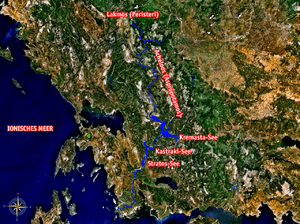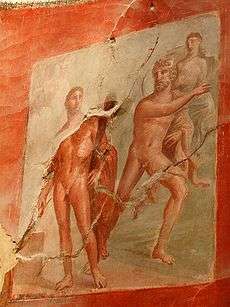Achelous River
| Acheloos | |
|---|---|
 | |
| Country | Greece |
| Basin | |
| Main source | Pindus mountains |
| River mouth |
Ionian Sea 38°19′53″N 21°6′5″E / 38.33139°N 21.10139°ECoordinates: 38°19′53″N 21°6′5″E / 38.33139°N 21.10139°E |
| Basin size | 5,472 km2 (2,113 sq mi)[1] |
| Physical characteristics | |
| Length | 220 km (137 mi) |
| Discharge |
|


The Achelous (Greek: Αχελώος, Ancient Greek: Ἀχελῷος Akhelôios), also Acheloos, is a river in western Greece. It formed the boundary between Acarnania and Aetolia of antiquity. It empties into the Ionian Sea. In ancient times its spirit was venerated as the river god Achelous.
Herodotus, taking notice of the shoreline-transforming power of the Acheloos River, even compared it to the Nile in this respect:
- 'There are other rivers as well which, though not as large as the Nile, have had substantial results. In particular (although I could name others), there is the Achelous, which flows through Acarnania into the sea and has already turned half the Echinades islands into mainland.' (2.10, trans. Waterfield)
The previous name was Thoas. It is rarely known as Thestios and Axenos.
Course
The river Achelous begins at about 2,000 metres (6,600 ft) elevation on the eastern slope of Lakmos mountain in the Pindus range, near the village Anthousa in the westernmost part of the Trikala regional unit. One of its first tributaries is the Aspropotamos, meaning the white river.
The river flows generally southwards, and forms part of the boundary between the regional units of Arta and Trikala, which is also the boundary between Epirus and Thessaly. Further downstream, it forms the boundary of Arta and Karditsa, and further of Aetolia-Acarnania and Evrytania. The river runs into the Kremasta reservoir, which is also fed by the rivers Agrafiotis and Megdovas.
On exiting the Kremasta reservoir, the river flows southwest into Aetolia-Acarnania, feeding the Kastraki reservoir, west of the Panaitoliko range. 10 to 15 kilometres (6.2 to 9.3 mi) downstream from this lake, it flows into the Stratos reservoir. Further downstream, it runs through the lowlands west of Agrinio. It finally empties into the Ionian Sea, 29 km (18 mi) west of Missolonghi.
Settlements
In order from upstream to downstream:
- Katafyto
- Gardiki
- Mesochora
- Koryfi
- Myrofyllo
- Petroto
- Grimpiana
- Mesopyrgos
- Neo Argyri
- Tripotamo
- Kastraki
- Stratos
- Palaiomanina
- Gouria
- Neochori
Dams
There are five dams on the river. From upstream to downstream there is the Mesochora Dam which was completed in 2001 but has not impounded its reservoir. Below that is the Sykia Dam which is partly constructed. Further down is the Kremasta (1965), Kastraki (1969) and Stratos Dams (1989).
Acheloos River in mythology
- Main article Achelous

History
In 1359 the Battle of Achelous between Albanian forces under Peter Losha and the Despotate of Epirus under Nikephoros II Orsini took place near the river Achelous. Nikephoros II was defeated and killed during the battle, and two new states were established in the area, the Despotate of Arta and the Despotate of Angelokastron and Lepanto.[2]
In the 1960s, the Kremasta Dam in the Aitoloacarnania-Evrytania boundary was under construction. The area is not forested. The dam, made of concrete, took years to complete, eventually flooding a portion of the western part of the prefecture of Eurytania. The dam includes a power station with transformer lines in the east. The dam powers electricity for the western part of Greece and the central part. It caused some soil erosion in some flooded valleys. The Kastraki Dam is downstream and was completed in 1969. Downstream of Katsiki, the Stratos Dam was completed in 1989. The arch bridges includes the Karafilio and the Ardanovo.
The Acheloos River Diversion project has been the center of debate since the 1980s. It calls for four large dams, the Sykia, Mesochora, Mouzaki and Pyli, along with a 17.4 km-long (10.8 mi) channel. The goal of the project is to divert 600,000,000 m3 (490,000 acre·ft) annually from the river west towards the Thessaly plains in order to help irrigate 240,000–380,000 ha (590,000–940,000 acres) of mostly cotton crops. Construction on the project has been stalled several times, the latest in 2005, because of environmental and social concerns.
Sources
| Wikimedia Commons has media related to Acheloos River. |
- ↑ TH. Fourniotis, Nikolaos (April 2012). "A Proposal for Impact Evaluation of the Diversion of the Acheloos River, on the Acheloos Estuary in Western Greece" (PDF). International Journal of Engineering Science and Technology. University of Patras, Rio Campus. 4 (4): 1793–1802. ISSN 0975-5462. Retrieved 25 April 2013.
- ↑ Van Antwerp, John (1994). The Late Medieval Balkans: A Critical Survey from the Late Twelfth Century to the Ottoman Conquest. University of Michigan Press. pp. 348â 51. ISBN 978-0-472-08260-5.
External links
- Acheloos Ancient Greece Iconography at Beazley Archive (Oxford University)
- (Archived 2009-10-31) - MSN Encarta
- Ecoguides on Achelous
- TV2 Travel Channel on Achelous
- Aspropotamos River
- (in Greek)
- (in Greek)
- (in Greek)
- (in Greek)
- (in Greek) - Trikalasport.gr
- (in Greek)